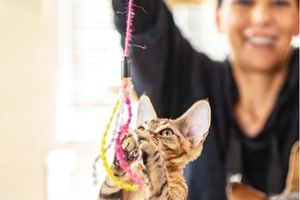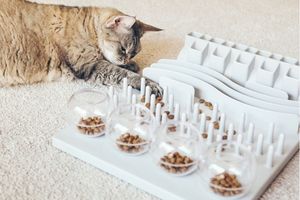Creating the perfect indoor haven
Did you know cats can thrive indoors and live long, healthy lives by your side? Here’s how to create a stimulating environment that keeps them happy and safe.
Cat toys

Cats have strong natural instincts and toys that help them replicate prey through sound, movement and different textures can engage these instincts, encouraging your cat to stalk, pounce and catch, and providing mental and physical stimulation.
Besides buying toys from stores, you can make simple and cost-effective toys at home, such as:
- toilet paper tubes
- paper-filled cotton socks
- crumpled paper balls.
Rotating between a variety of safe, stimulating toys will help keep your cat happy.
Scratching posts
Scratching is a natural behaviour for cats, driven by several instincts. They use scratching to sharpen their claws, stretch their muscles and relieve stress. Additionally, cats have scent glands in their paws and scratching is a way for them to mark their territory.
To discourage your cat from scratching your furniture, offer a variety of scratching surfaces, both horizontal and vertical. Adding a sprinkle of catnip can further entice them to use these posts and surfaces.
Cat comfort zones
Cats are territorial creatures and need their own personal space, especially in multi-cat homes, to prevent aggression. Cats enjoy sleeping in cozy spots, so provide hideaways like empty cardboard boxes or other enclosed spaces for privacy and security.
Offer elevated places like shelves, window ledges and tops of furniture. These can provide sunshine, fresh air, a sense of security and enrichment, and allow them to observe their surroundings.
Social needs and playtime
Cats enjoy spending time with people, but on their own terms. Short, positive interactions (5 to 10 minutes) work best. Some cats prefer just being in the room, while others love playtime, cuddles or brushing. Letting your cat take the lead builds trust and strengthens your bond.
While not essential, safe outdoor access can be provided through outdoor enclosures, escape-proof fencing or short supervised backyard strolls to allow for outdoor sights, smells and sounds.
Food and water
Cats don’t like to eat or drink near their litter box. Keep their food and water bowls in a separate location, with some space between them as well. Feed cats small amounts frequently.
 To stimulate your cat’s natural instincts, avoid a bowl and consider toys, puzzles or scatter feeding.
To stimulate your cat’s natural instincts, avoid a bowl and consider toys, puzzles or scatter feeding.
Scattering kibble across the floor and their scratching platforms encourages exploration and slows feeding, which encourages digestion and exploration, and reduces the chances of vomiting caused by eating too quickly.
Many common household items can be toxic or dangerous for cats so it’s essential to keep them secure or out of reach. Hazardous items include:
- lilies
- chocolate
- citrus
- cooked bones
- onions
- garlic
- grapes
- alcohol
- coffee
- dairy products.
Other dangers include:
- chewing on electrical cords
- ingesting human medications
- insecticides and cleaning products.
Litter boxes
Each cat should have their own litter box in a quiet, private and accessible spot. The litter box should be large enough for the cat to turn around and squat, and deep enough for your cat to dig and cover their waste.
Cats like to keep clean and will avoid dirty litter boxes. Scoop the tray daily and wash it regularly.
If you are pregnant, have someone else empty or clean the litter box for you to minimise the risk of toxoplasmosis, a rare disease found in cat faeces that can be harmful to unborn babies.
Download a printable version of this page: Creating the perfect indoor haven for your cat ![]() [PDF File - 692.6 KB]
[PDF File - 692.6 KB]